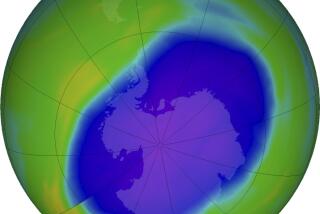Puzzling ‘Hole’ Appears in Atmospheric Layer Each Spring : U.S., Soviets to Study Antarctic Ozone
- Share via
WASHINGTON — U.S. and Soviet scientists have agreed to cooperate in studying the puzzling “hole” that develops each spring in atmospheric ozone over the Antarctic continent, the National Oceanic and Atmospheric Administration said Thursday.
A thin layer of ozone in the stratosphere protects the Earth from damaging ultraviolet radiation from the sun. The recent discovery of a cyclical hole in Antarctic ozone has led some scientists to conclude that man-made chlorofluorocarbon chemicals (CFCs) are depleting the ozone layer more rapidly than once thought.
Others believe the hole may be a natural phenomenon, caused by streams of charged particles expelled by the sun, or a combination of the two causes.
Visiting Researchers
The new agreement, reached with visiting Soviet researchers at the federal agency’s Boulder, Colo., research center, calls for the United States to supply 50 small instrument packages worth about $30,000 that the Soviets will launch aboard weather balloons from their Molodezhnaya research station in Antarctica.
These and identical instruments launched from the U.S. research station at the South Pole will produce a narrow but detailed “profile” of ozone readings up to about 98,000 feet, while simultaneous observations from U.S. satellites will provide a wide-angle view of changing conditions in the ozone layer over the entire continent, Dr. James Peterson said.
An atmospheric scientist with NOAA’s Air Resources Laboratory in Silver Spring, Md., Peterson said the ozone study is part of a 10-year-old cooperative program with the Soviets that has “waxed and waned over the years with international relations.” The ozone study is expected to begin in September or October.
Scientific Exchanges
Because of a resurgence under way in scientific exchanges with the Soviet Union, NOAA officials said it is likely that additional projects will be agreed upon to measure trace gases in the Arctic atmosphere that may reflect man’s impact on the global climate.
The Antarctic ozone hole--a depletion of 35% to 50% from normal levels--was first noticed in 1985 but appears to develop each September and October, spring in the Southern Hemisphere. Its discovery has intensified worldwide concern that CFC chemicals widely used as refrigerants are causing a similar, if smaller, erosion of the ozone layer on a worldwide scale.
The U.S. Environmental Protection Agency has estimated that each 1% reduction in ozone would lead to an additional 20,000 cases of skin cancer in the United States alone, besides damaging crops and altering the global climate. The United States, which banned the use of CFCs as aerosol spray propellants in 1978, is negotiating with 30 nations including the Soviet Union for worldwide control of the chemicals.
A tentative agreement signed in Geneva in April calls for a 20% reduction in CFC emissions by 1992, but the State Department has pledged to pursue its original goal of a 95% reduction over the next decade.




